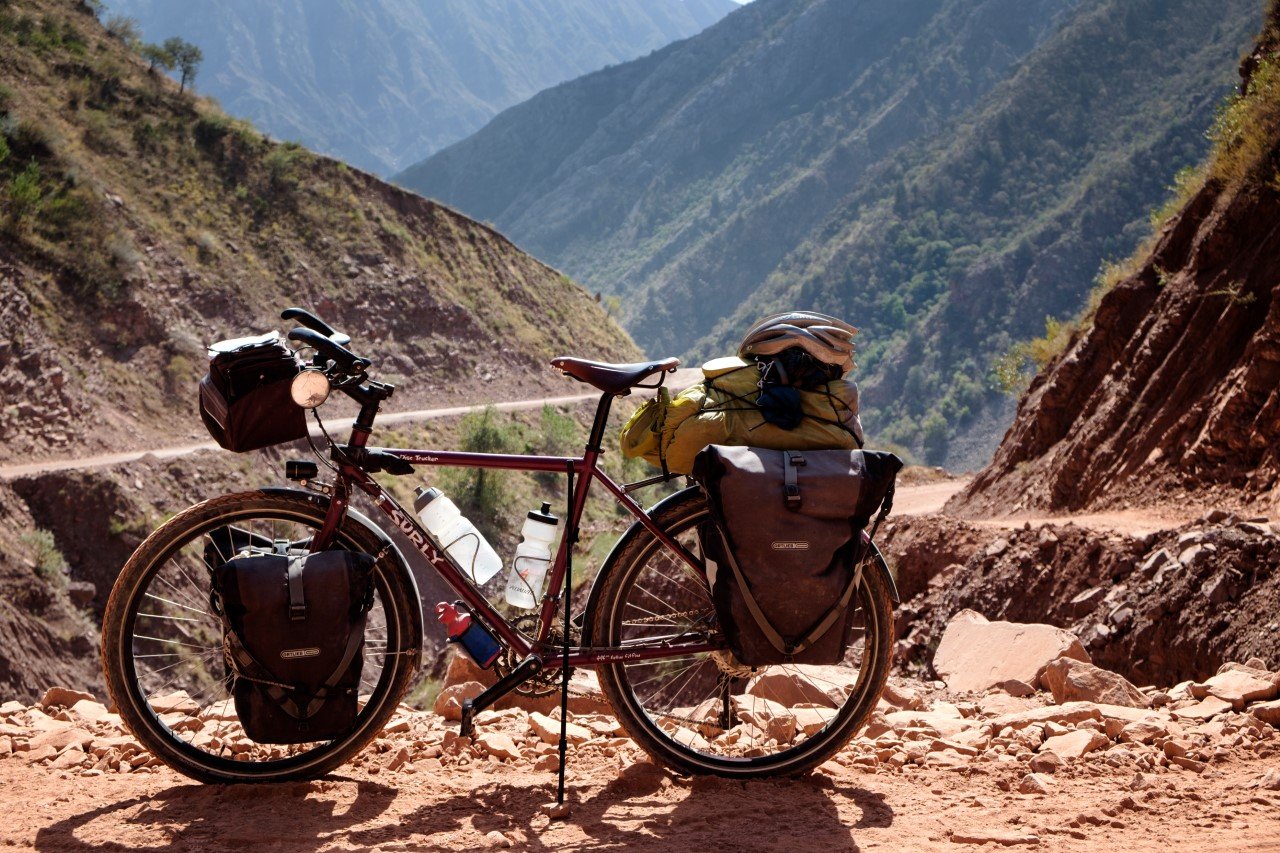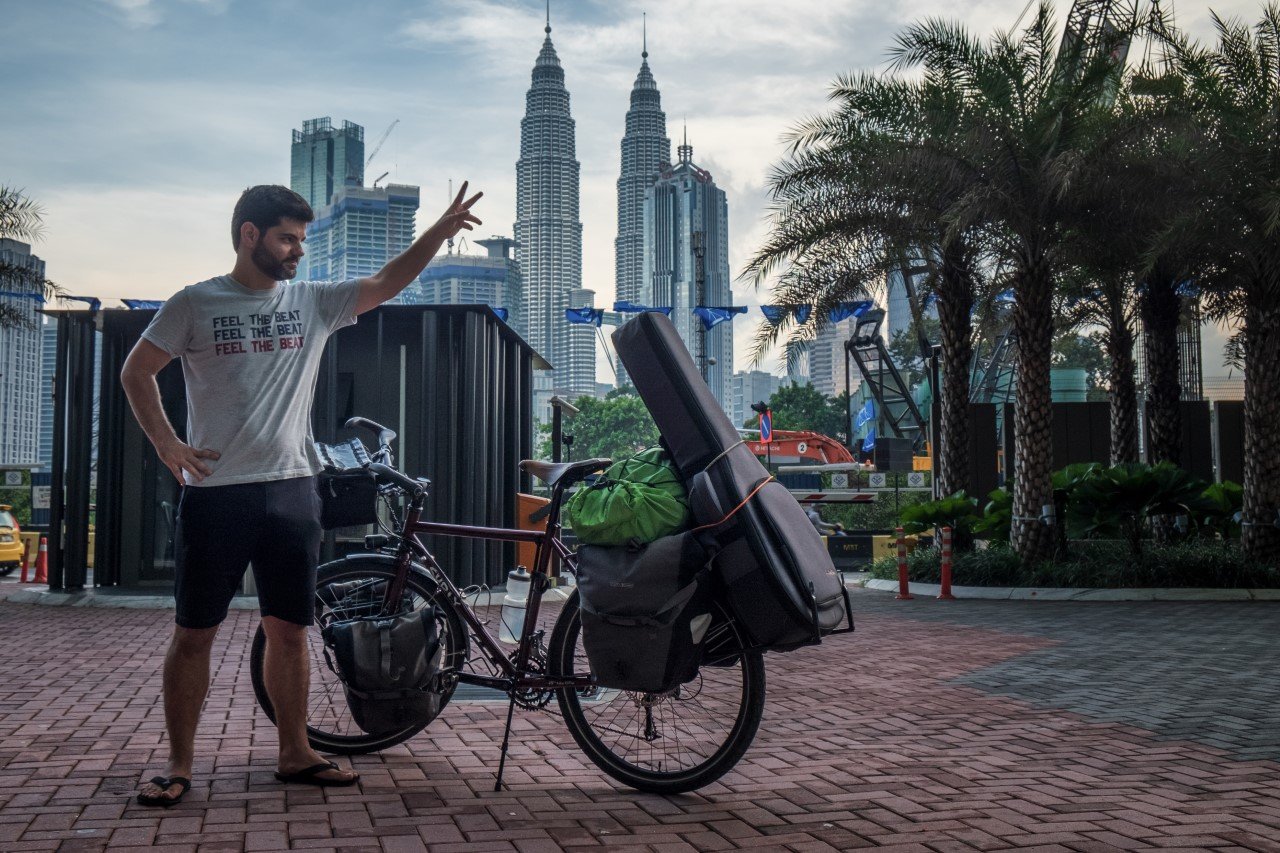Cycle tourism: panniers or trailer?
This post was first published on the La Cordée store blog.
After two of my four saddlebags unhooked and glided over a gravel road in Bolivia, I wondered if it wouldn't have been better to go with a trailer. After a long reflection, I weigh here the pros and cons of the two systems.
Reading the articles on the internet that talk about this subject, you get the impression that the two ways of loading your bike — panniers and trailer — are equally popular.
This is not the case! In four years on the road, I can probably count on the fingers of one hand the cyclotravelers I've passed who were pulling a trailer. (Compared to several hundred who carried their black, red or blue bags on the sides of their bikes.)
Each of the trailer pullers, however, had a specific reason or object to carry to motivate this choice: a dog, a guitar or even a kitesurf board. For other two-wheeled travellers, the saddlebag-or-trailer question arises. Here are the lines of thought that I propose to you so that you can make an informed choice.
The Swiss Nicholas, in the company of his girlfriend Siria, has chosen to add a trailer to his bike to transport his kitesurf board.
Trailer
Aerodynamics and stability: Once the first pedal strokes are given, you no longer feel that you are pulling anything if the total weight pulled is less than 35 pounds, and if the trailer has only one wheel. The single wheel trailer is more aerodynamic than the two wheel trailer since it is the same width as the bike. In short, the only reason that would justify having a two-wheeled trailer would be to have to travel with a dog or a child.
On rougher trails, even the best panniers can sometimes come loose. However, with a trailer, the risk of rolling your electronic equipment in the garnotte is almost zero. Not to mention that as the center of gravity of the trailer is low, it helps the stability of the mount when traveling.
Weight : You might mistakenly think that the trailer weighs a lot more than the saddlebags, but in reality, their weights are very similar. For long trips, we often leave with 4 panniers, in addition to a waterproof bag on the luggage rack. To this must be added the weight of the two racks which, when made of steel, actually add weight to the mount.
No kickstand needed: By placing the bike at an angle with its trailer, it stands up on its own. No need to have a kickstand on your bike.
My bike adorned with my six bags, and supported by a custom-made Click-Stand kickstand. The kickstand is not necessary with a trailer.
Large objects: As mentioned above, the trailer is much more practical for transporting large objects, heavy equipment or a lot of equipment. However, this possibility may encourage the cyclist to bring more equipment than necessary. And carrying a lot of equipment often means having less fun on the road…
A single bag to manage: The single large bag that fits in the trailer is usually very waterproof. By being away from the wheels of the bike, it will also receive less water laterally. As it is large, this bag must however be subdivided using a system of smaller bags (waterproof or mesh bags) to facilitate storage and find your way around easily.
With any bike: The greatest advantage of the trailer is without a doubt that it can be installed on any type of mount: road bike with narrow tires, mountain bike with double suspension, old bike without attachment system for luggage racks. It is usually sufficient to replace the rear quick release (quick release) by that of the trailer and you're done. It is also extremely easy to detach from the bike. Note that you must choose a special trailer for new bike models that have a hitch of the type thru axle, wider than the conventional quick release.
Transportation: The trailer is certainly more complicated to transport on planes, trains and buses. The trailer hitch rod comes undone and can be inserted inside the trailer. Two trailers can fit inside each other, be tied together and put in a plastic bag for air travel. This additional baggage therefore incurs additional costs.
Transporting the trailer is easier on trains and buses, but it may entail either additional costs or even the possibility of being denied access to the baggage compartment if it is already full.
More parts: You have to drag a room à air extra to fix the trailer wheel. This also means possible breakage on several parts, including the clamp, the spokes and the tire. The latter, usually 20 inches, is also harder to find.
With a little imagination, there are other ways to transport large objects… like a guitar! Here in Kuala Lumpur, Malaysia.
Saddlebags
More difficult to fly: A big bag is easier to steal than 4 panniers. In addition, the system for unhooking the latter is generally less known and scares neophytes (that is to say almost the whole planet) more.
Ease of transportation: Climbing narrow hotel steps may be easier with panniers than a huge trailer bag. Panniers are also easier to place on the train, bus or plane.
Easier to maneuver: As a bicycle with panniers is shorter than a bicycle with a trailer, it is therefore much easier to weave between cars in town with panniers. Not to mention that it is less risky to be hit by a vehicle.
However, it is really important to balance the weight of the panniers. Otherwise, especially at high speeds, the imbalance will be felt. Note that it is much more stable to add panniers to the front of the bike rather than just to the rear. In the latter case, the difference in weight makes it more difficult to shoulder the bike and you often have the impression that the front wheel lifts off the ground or does not hold on to it well.
When traveling with two or four panniers, it is very useful to install an elastic band on the handlebars to apply the front brake when the bike is stationary. This prevents the heavy bike from moving when it is parked somewhere.
More versatile: Once the racks and panniers have been purchased, it is possible to change the number of panniers to bring depending on the duration of the trip. A single bag for going to work, two for a weekend trip, four for several weeks in the wild, etc.
Waterproofing: Some panniers are not completely waterproof. You have to make sure to choose ones that are of good quality to avoid unpleasant surprises.
Maintenance : Whenever you remove or replace the panniers, you must pay attention that they are properly attached to the luggage rack. On the worst trails, I've had to tie mine up with rope in a few places on my rack. Over time, especially if the saddlebags are heavily loaded, the plastic pieces that hold them in place can expand. It is therefore necessary to periodically tighten the screws of the luggage rack and the panniers so that everything remains in place.
My pannier system, photographed for a Brazilian newspaper.
In short
The overwhelming majority of road travelers decide to go for the panniers over the trailer. In my opinion, there are few cases where a trailer is the best option. Every time you have to take the plane or public transport to get somewhere, the trailer is much more complicated to handle.
However, if your bike is not well equipped to fit a rack or if your trip requires you to choose a mountain bike, then the trailer might be the right choice for you. In addition, for trips on rougher or narrower trails, and generally of shorter duration, a more modern system of the bikepacking type (frame bag, large saddle bag and waterproof bags at the fork) is also interesting. This will be the subject of a future article.
Bon voyage!










After two of my four saddlebags unhooked and glided over a gravel road in Bolivia, I wondered if it wouldn't have been better to go with a trailer. After a long reflection, I weigh here the pros and cons of the two systems.